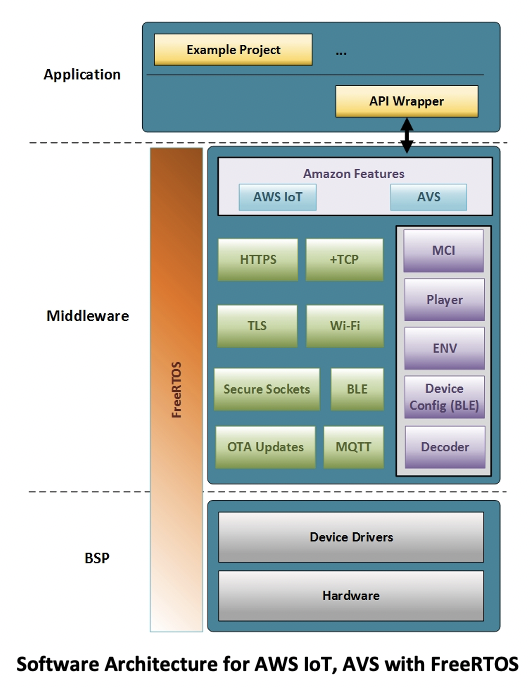Do you know that FreeRTOS, one of the globe’s most famous embedded operating systems, isn’t on most users’ radar screens? Yes, despite its prominence with embedded programs, most people haven’t discovered it.
FreeRTOS also anonymously strengthens several devices we bother about, from toy cars to aircraft navigation systems. Thus, it was considered critical for AWS not just to maintain but to grow the open community around FreeRTOS while majorly enhancing its security and connectivity.
Talking about the role of FreeRTOS, Alexa Voice Service, and AWS IoT Core together in IoT is quite crucial. Nowadays, there is an increased demand for Voice and IoT solutions with low cost, low footprint, low power and low CPU utilization.
FreeRTOS plays a vital role in the IoT industry by adding AWS IoT core for cloud and Alexa Voice Service for Voice Control, reducing the effort and time for the developers or customers, enabling IoT products to have a faster time to market.
This integration will bring peace to developers, freelancers, manufacturers (ODMs), and customers (OEMs) as they no longer need to worry about integrating key services like AWS and AVS on FreeRTOS.
They can directly get started with the application/use case development towards the product plan or make any existing product into a smart product with minimal effort from their engineering team. Besides, it reduces the risk of their POC effort.
FreeRTOS with AWS and AVS SDK for Customers and Developers
Making your appliance ‘Smart’ is the next big thing. With the advancement in IoT technology, leading SOC vendors and Solution providers are investing their time and resources in breaking barriers. The challenge is to build a small footprint, low cost and low power solution.
Voice to Cloud Architecture for the IoT devices
The joy and amusement you receive while interacting with a device with your own voice are boundless. The vast market invasion of voice-enabled AI assistants such as Amazon Alexa has made this voice interface and interactions common nowadays.
By enabling Amazon Alexa in your IoT device and taking advantage of easy-to-use Amazon Web Services such as AWS IoT opens up numerous opportunities across the spectrum.
The user’s voice commands are uploaded to the Alexa Voice Service cloud; the cloud then processes it and determines the course of action.
The voice commands are processed and forwarded to third-party (3P) clouds to execute an action using Alexa Skill Infrastructure. These 3P clouds can be set up using Amazon Web Services, while AWS IoT can be used to send control information to the device over MQTT.
On receiving the command, the device can take up appropriate action, which can be anything from switching on a motor to firing away IR signals with the help of an IR transmitter to changing the settings on an external SOC/DSP.

Software SDK with FreeRTOS
FreeRTOS placed in Libre SDK is simplified and is customizable with AWS and AVS voice features along with standard MAVID-3M EVK based on MediaTek/Airoha’s SOC AW7698. Multiple clear-cut and coherent documents will be provided along with the SDK for developers to understand the initial POC over open forums and FAQs.
The SDK is accessible on the website along with the EVK purchase. EVK can be purchased from e-Commerce sites (Digi-Key, Mouser and Amazon). The FreeRTOS based SDK is simpler and faster to integrate with example codes for AWS connection, SPI, I2C, UART and GPIO based appliances/device controls. Users can customize the development board/kit for rapid prototyping/proof of concept, Hardware documentation. You can download the EVK guide from the website.

The above EVK will help in reducing R&D efforts for developers and customers to make a proof of concept and bring their product to Voice and IoT.
The SDK is separated into different sections for better understanding, making it easier for the user to visualize and know the components available on the SDK release.
It can be broadly divided into three layers:
- The BSP layer contains device drivers and hardware abstractions.
- The Middleware layers consist of software modules such as AVS, MQTT, and several system-specific modules supporting networking, voice interaction, media streaming and playback.
- API wrappers expose middleware modules to Applications. Using the wrapper APIs, engineers will develop a wide range of secure voice-enabled IoT custom applications.

Challenges on taking it to Mass Production (MP)
It is always easy to make a quick POC and get the product budget approval. The real challenge is to get it into Mass Production (MP).
- Provisioning AWS IoT Core: Bulk provisioning of IoT devices has always been a challenge on the MP line as we need to run millions of devices on it. AWS Fleet provisioning options and MP tools for provisioning have made it easy.
- Security: Secure boot, secure connection/communication, secure OTA, and secure storage are crucial for a network/IoT device. We have followed best industry practices and the latest libraries for making the device secure and safe for the end customers preventing tampering of any user data.
- Acoustic Performance: Achieving voice detection on the finished product is a major challenge, but it can be resolved to a great extent with acoustic performance like fine-tuning performed as part of the product life cycle process is carried out properly with expertise.
- OTA: Secured and controlled OTA update to the devices on the field. Additional features such as remote diagnostics, debugging, and tracking of IoT devices in the field can be made a part of our SDK on special requests.
Low power Mode:
Different power saves options include:
Active mode – Streaming mode
Sleep Mode: The device wakes up on interrupt and periodically wakes up to ping AVS. If AVS is already logged in, the response will be quick.
Standby Mode: The device wakes up on interrupts, and AVS needs to initiate again in this scenario. AVS response will be slower.
Deep Sleep Mode: The device wakes up on interrupts. All the modules should be re-initialized.
Summary
These latest IoT development platforms based on the FreeRTOS SDK with AWS and Alexa Voice Service will make it easier for the initial product developers/customers to reduce the time frame with the example applications, cloud formation, a standard mobile application for setup/login, and hardware reference documents.
FreeRTOS is a timely need with its widely used low memory/CPU IoT development boards or SoCs. The addition of AWS IoT, Alexa Voice services, and supporting applications for mass production has saved time and reduced effort for the initial stage developers or customers to get into product approval and sign off.
If you want to try out our FreeRTOS based MAVID-3M SDK kits, refer the below link:
https://www.digikey.com/en/products/detail/libre-wireless-technologies/00-12400-00/14010209
Authors
Vadivelu Narain,
Director,
Libre Wireless Technologies.
Nagarjuna Sundaresh,
Technical Manager,
Libre Wireless Technologies.
For Sales Contact:
sales@librewireless.com







